AUCTORES
Globalize your Research
Research Article | DOI: https://doi.org/10.31579/2578-8965/266
1Health Systems and Service Consultant, Addis Ababa, Ethiopia.
2Head of Reproductive Health and Population Studies Department, Addis Continental Institute of Public Health, Addis Ababa, Ethiopia.
3Department of Biostatistics, College of Science, Debre Tabor University, Debre Tabor, Ethiopia.
*Corresponding Author: Mekonnen Muleta Debel, Health Systems and Service Consultant, Addis Ababa, Ethiopia.
Citation: Mekonnen M. Debel, Tigest Shifraw, Alebachew T. Belay, (2025), Knowledge of Emergency Contraceptives and Associated Factors among Female Students of Government High Schools, Addis Ababa, Ethiopia, J. Obstetrics Gynecology and Reproductive Sciences, 9(4) DOI:10.31579/2578-8965/266
Copyright: © 2025, Mekonnen Muleta Debel. This is an open-access article distributed under the terms of The Creative Commons Attribution License, which permits unrestricted use, distribution, and reproduction in any medium, provided the original author and source are credited.
Received: 05 May 2025 | Accepted: 15 May 2025 | Published: 21 May 2025
Keywords: knowledge; emergency contraceptives; females; adolescents; bole sub-city
Background: Emergency contraception (EC) is an effective contraceptive method or procedure used by adolescents to avert unwanted pregnancy following unprotected sexual intercourse, due to missing or non-use of regular contraceptives methods. Unwanted pregnancy and unsafe abortions are major public health problems in limited-resource countries especially for adolescents. However, there are documented knowledge gaps on EC among female high school students in Ethiopia.
Objectives: This study aimed to assess the knowledge of EC and associated factors among female students in government high schools in Bole Sub-city in Addis Ababa, Ethiopia.
Methods: A cross-sectional study was conducted with simple random sampling to select 634 female students in 2/6 governmental high schools using a multi-stage sampling technique resulting. Data were collected by using a self-administered questionnaire and entered in EpiData version 3.1 and analyzed using STATA 15. Descriptive statistics, bivariate and multivariable logistic regression analysis were used to assess associations.
Results: The magnitude of EC knowledge was 41.6% (95% CI: 37.77, 45.59) among female high school students. The level of knowledge towards EC is significantly associated with females ages 18 years and above [AOR = 3.88; 95 % CI (1.09, 13.85)], married [AOR = 3.64; 95 % CI (1.46, 9.04)], having boyfriend [AOR = 1.85; 95 % CI (1.15, 2.99)]; having discussion about reproductive health (RH) issues with their parents [AOR = 1.80; 95 % CI(1.24, 2.61)]; and having sexual intercourse history [AOR = 5.22, 95 % CI (1.42,19.24)].
Conclusion And Recommendation: The study documents an inadequate level of knowledge towards EC among female students in two government high schools in Ethiopia. There is a need to educate all female high school students about EC as it helps them prevent unintended pregnancies and empower them to make informed choices about their sexual and reproductive health rights.
Emergency contraception (EC), is an effective contraceptive method or procedure that can be used by adolescents to avert unintended (unwanted) pregnancy following unprotected sexual intercourse, skipping use of regular contraceptives methods or non-use of contraception to prevent unintended pregnancy or unplanned pregnancy [1]. There are two types of ECs namely, oral emergency contraceptive pills (ECPs) and intrauterine contraceptive devices (IUCDs) [2]. When used within 72 hours after sexual intercourse, EC pills are up to 85% effective to prevent pregnancy, while with the use of IUCDs unwanted pregnancy can be averted in 99% of the cases [3]. EC offers an unparalleled opportunity for preventing pregnancy after unprotected sex that no other contraceptive method can provide.
According to the United Nations Population Fund (UNFPA) report (2022), globally about 257 million women who want to avoid pregnancy are not using modern methods of contraception [4]. Nearly half of these pregnancies are unintended. Additionally, over 60% of these unintended [unwanted] pregnancies end as unsafe abortion that could be the cause of 5-13 % of all maternal mortality [5].
In Ethiopia, early initiation of sex poses a major challenge to the young generation. According to the 2016 Ethiopian Demographic Health Survey (EDHS) report, 24% and 62% of women initiated sex before the ages of 15 and 18 years, respectively. The EDHS 2016 report also indicated that only 4% women of reproductive age use emergency contraceptives [6].
Female students are among the young generation who become sexually mature while in high school. Female high school students are also one of most vulnerable groups of the population for unintended pregnancy in Ethiopia [7, 8]. For example, a study conducted on the prevalence and determinants of unintended pregnancy among female high school students in Arsi Zone, Ethiopia indicated that about 30% of them had experienced had an unwanted pregnancy [9]. These girls may be compelled to either dropout from school or chose an unsafe abortion or early childbearing. Critically, unwanted pregnancies have a negative impact on the girls’ educational progress, future careers and social interactions and relationships with parents, schoolmates and community members [10, 11]. It is imperative that female high school students complete their secondary school education and beyond without any risk of unwanted (unintended) pregnancies. Thus, they should be protected from unintended pregnancy that could have been considerably prevented using EC.
A lack of knowledge towards emergency contraception has been identified as a main reason for not utilizing EC among women and adolescents [10]. Without adequate knowledge, adolescent girls cannot make an informed and timely decision to utilize EC for the prevention of unintended (unwanted) pregnancies [11]
Recent studies have shown that socio-demographic factors and limited knowledge of modern contraceptives impede effective utilization of EC among female high school students in Ethiopia [12, 13] . Equally, inadequate knowledge of EC among female high school students was found to be significantly associated with unintended (unwanted pregnancies) and unsafe abortions [12]. It is recommended that female students’ knowledge of EC and associated factors is the first step toward accepting and utilizing modern contraceptive methods. Thus, this study was conducted to assess knowledge of EC and associated factors among female students in government high schools in Addis Ababa, Ethiopia.
In Ethiopia, most studies conducted on knowledge of EC focused on university and college female students. There are few studies conducted on the knowledge of emergency contraceptives EC among female high school students in Addis Ababa. Thus, this study was conducted with an intention to assess the level of knowledge of ECs and associated factors among female students of government high schools of Bole Sub-city and Addis Ababa, Ethiopia.
Methodology
Study Setting: This study was conducted in Addis Ababa City Administration in Bole Sub-city. At present, the Sub-city has 14 districts with an estimated population of 435,421 in 2022. According to the Education Office of the Bole Sub-city, there were 24 high schools in 2023. Among these, 18 are private high schools and 6 are governmental high schools. The study was conducted from January to April 2024 in two governmental high schools.
Study design: The study employed an institutional-based cross-sectional study design.
Source Population: The source population included all female high school students registered in the academic year of 2016 Ethiopian Calendar in Bole Sub-city, Addis Ababa, Ethiopia.
Inclusion Criteria: All female students in grades 9, 10, 11 and 12 who were studying at the 2 high schools and gave consent during the study period.
Exclusion Criteria: Female high school students who did not want to participate in the study. In addition, female students who were sick, visually impaired or mentally ill during the study period were excluded.
Sample size: The sample size was determined by using a single population formula with an assumption of the prevalence of EC knowledge among female high school students was 54.8%, which was taken from a study conducted in 2020 by the Department of Public Health, Wolkite University College of Medicine and Health Science, Wolkite, Ethiopia [12]. Thus, with a confidence interval at 95% and 5% margin of error, the sample size was determined at 380. The sample size was calculated using the following formula:
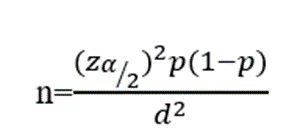
Thus, considering the design effect of 1.5 and using correction formula for finite population by adding non-response rate of 10% the final sample size was 634.
Sampling Procedures: A purposeful multistage stratified sampling technique was applied to select study participants in randomly chosen 2/6 government secondary high schools in Bole Sub-city (Figure 1).
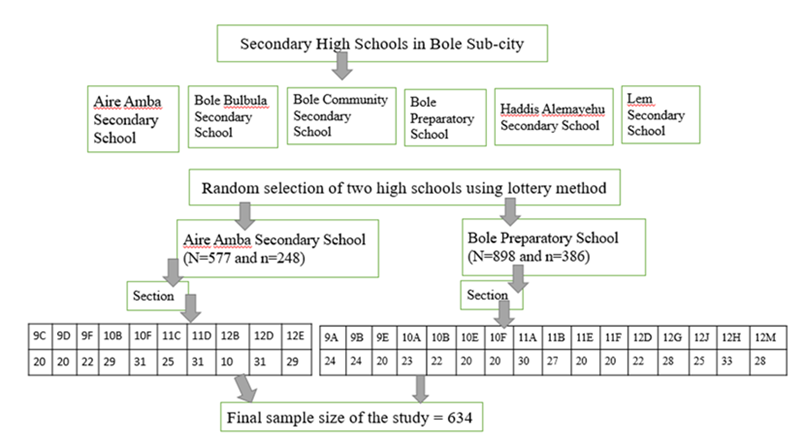
Figure 1: Multi-stage stratified sampling technique of the study
Instrument: Data was collected using a structured self-administered questionnaire in Amharic, the local language. There were a total of 29 questions on the instrument. Nine items were related to EC knowledge-related questions on the questionnaire scored 1 point each. Scores could range from 0-10. Each student’s total score was calculated (maximum possible was 10 points). Nine items were related to previous sexual and pregnancy history. Responses on the questionnaire were anonymous.
Data collection procedures: Two data collectors with a BSc in health-related fields were recruited to conduct this study. Before field work, training was provided to the data collectors on topics related to the objective of the study, the contents of the questionnaire, quantitative research methods, data quality, privacy and study participant rights.
Data quality: To ensure instrument quality, pre-test was conducted on 5% (32 female students) of the total sample size of 634 at other secondary school which is outside of the study area. Data quality was checked for completeness, clarity, and consistency by the principal investigator at each point. In addition, the data was cleaned; coded and double data entry into EpiData (classic) Entry version 3.1 was made to minimize errors. Data analysis was done using STATA 15.0.
Data analysis: Students considered to have adequate knowledge of EC if they scored ≥5; inadequate knowledge was a score<5 [15]. Descriptive statistics, e.g., frequencies, percentage, mean, and standard deviation were computed for study participant characteristics. The level of EC knowledge was measured by data from 10 EC knowledge-related items. The total score for every participant was calculated as the sum of the score for individual responses; the response range was 0-10 [13,14,15].
Bivariate and multivariable logistic regression analyses were done to identify associations among dependent and independent variables using STATA 15.0, at 95% confidence interval by adjusting for confounding factors. A bivariate logistic regression analysis was done to determine the associations between independent variables and the dependent variable. Statistical significance was set at p-value < 0.25. For inferential statistics, logistic regression analysis was employed to determine the association between
dependent and independent variables. A p-value of < 0.05 was considered to be statistically significant. The results are presented in tables 1-5 and figure 2.
Operational definitions:
Emergency contraception (EC): contraception methods that a woman of reproductive age may use after unprotected sexual intercourse, contraception failure, incorrect contraceptive use, or sexual assault [16].
Sexually active: having a history of vaginal sexual intercourse.
EC knowledge: Awareness of the existence of EC, its importance, and effectiveness.
Socio-demographic characteristics of the participants
A total of 634 female high school students participated in the study with the response rate of 100%. Most of the 516 (81.4%) of female students were between 15 and 18 years of age. The mean age was 17.22 (SD ±1.536) years. Two hundred and twenty-eight (32.8%) of the female students were in grade 12. The majority of the female students 610 (96.2%) were single (unmarried), while 24 (3.8%) were ever married. Only 96 (15.1%) of the female students had boyfriends at the time of the study. Most of the 466 female students (73.5%) were followers of Orthodox Christianity. Of the total participants, a minority of female students 167 (26.3%) said that they had discussed Reproductive Health issues with their parents. More than half (354) (55.8%) of female students lived with both parents, 134 (21.1%) lived with their mother alone, 31 (4.9%) with their father alone, and 115 (18.1%) lived with others (friends, husband, alone, or relatives). About three-fourths (490) (77.3%) of the girls’ mothers had graduated from Grade 12 or below, 73 (11.5%) had acquired a certificate, 34(5.4 %) a diploma and 37 (5.8%) a bachelor’s degree or above. For the girls’ fathers, 445 (70.2%) grade 12 or below, 91(14.4%) had acquired certificates, 25 (3.9%) a diploma, and 73 (11.5%) a bachelor’s degree or above. Most of the students’ families 498 (78.5%) had monthly income below 10000 Birr (76USD) (Table 1).
| Variables | Frequency | Percentage | |
| Age | less than 15 years | 18 | 2.8 |
| 15 – 18 years | 516 | 81.4 | |
| 18 years and above | 100 | 15.8 | |
Grade level
| 9th | 128 | 20.2 |
| 10th | 145 | 22.9 | |
| 11th | 153 | 24.1 | |
| 12th | 208 | 32.8 | |
| Marital status | Never married | 610 | 96.2 |
| Ever married | 24 | 3.8 | |
| Having boyfriend | No | 538 | 84.9 |
| Yes | 96 | 15.1 | |
Ever discussed RH issues with parents | No | 465 | 73.3 |
| Yes | 167 | 26.3 | |
| Living conditions | Mother alone | 134 | 21.1 |
| Father alone | 31 | 4.9 | |
| Both parents | 354 | 55.8 | |
| Othera | 115 | 18.1 | |
Mothers’ educational level
| Grade 12 and below | 490 | 77.3 |
| Certificate | 73 | 11.5 | |
| Diploma | 34 | 5.4 | |
| Bachelor’s degree and above | 37 | 5.8 | |
Fathers’ educational level
| Grade 12 and below | 445 | 70.2 |
| Certificate | 91 | 14.4 | |
| Diploma | 25 | 3.9 | |
| Bachelor’s degree and above | 73 | 11.5 | |
| Family income per month | Below 10000 | 498 | 78.5 |
| 10000-20000 | 83 | 13.1 | |
| Above 20000 | 53 | 8.4 |
aOther living conditions include living with friends, with husband, alone, and with various relatives.
Table 1: Socio-demographic characteristics of female students in Bole Sub-city, Addis Ababa, March 2024, who participated in the study.
Sexual and risk behaviors and history of pregnancy
Of the total of 634 female participants, 34 (5.4%) had had sexual intercourse during their lifetime. Of those who had had sexual intercourse, 9 (1.4%) initiated sexual intercourse at the age of 18 years and above, while 25 (3.9 %) of them had been younger. For those who had ever had sexual intercourse, 15 (2.4%) reported a pregnancy; 8 (1.3%) became pregnant under 18 years and 7 (1.1%) 18 years or older. Of those pregnancies, 12 (1.9%) were unwanted. Five girls (0.8%) continued with pregnancy to deliver a baby, while 10 (1.6%) induced an abortion The reasons mentioned for unwanted pregnancies were contraception failure three (0.5%), forgetting to take contraceptives three (0.5%), partner pressure to have unprotected intercourse three (0.5 %), condom slipped / broke two (0.3%) and one (0.2%) occurred due to forced sex. Five (0.8%) continued their pregnancy to deliver a baby, while 10 (1.6%) experienced an induced abortion (Table 2).
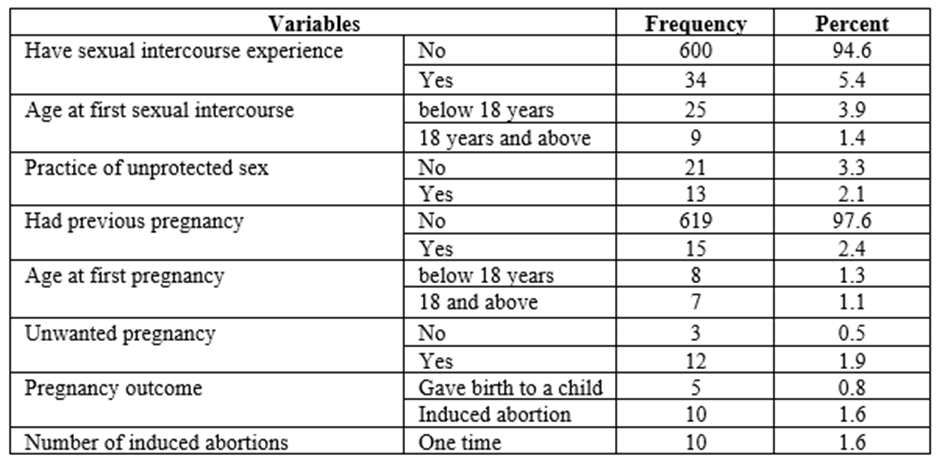
Table 2: Sexual and risk behaviors and history of pregnancy of female students.
Knowledge of emergency contraception
The prevalence of girls who had adequate EC knowledge was 264 (41.6%) (95 % CI: 37.77, 45.59). Almost half of the female students 294 (46.4%) had heard about EC. Of those who have heard about EC, 105 (16.6%) reported they knew about ECP and 130 (20.5%) knew about IUCDs. The rest, 202 (47.6%) of the female students incorrectly mentioned condom and implant as methods of EC (Table 3).

Table 3: Knowledge of emergency contraceptives among female students in two secondary high schools in Bole Sub-city, Addis Ababa, March 2024.
Most female students 109 (17.2%) received information regarding EC from TV, followed by 80 (12.6%) from regular education they got in schools, friends/peers 74 (11.7%), family 66 (10.4 %), hospitals/health institutions 63 (9.9%), social media 62 (9.8 %), books 43 (6.8%) and radio 29 (4.7%) (Figure 2).

Figure 2: Frequency of source of information about emergency contraceptives for female students in two secondary high schools in Bole Sub-city, Addis Ababa, Ethiopia.
With regard to the recommended time limit ECP that could be used effectively, 148 (23.3%) of female students did not know it was within 72 hours after unprotected sexual intercourse. 56 (8.8%) female students
correctly identified 72 hours as the time limit to take ECP after unprotected sex.
Similarly, most of the female students 158 (24.9%) did not know the recommended time to have an IUCD inserted into the uterus to avoid pregnancy. This implies that most girls in this study did not have knowledge about the recommended time to take EC. A few, 22 (3.5%) correctly said that the IUCD should be inserted into the uterus within 5 days after unprotected sex.
When asked about where one can purchase (obtain) ECs, 205 (32.3%) of the girls indicated that they could get them from pharmacy/drug vendors followed by government hospitals and 137 (21.6%) indicated government health centers. A smaller group, 122 (19.2%) said EC could be obtained from private clinics and 104 (16.4%) mentioned government hospitals. A few, 61 (9.6%), identified family guidance associations, 35 (5.5%) and 28 (4.4%) mentioned DKT- International and shops as common places from where they could obtain ECs respectively.
Table 4 shows that 192 (30.3%) of the girls did not know the efficacy of IUCD in preventing unwanted pregnancy. Another 73 (11.5%) correctly indicated that the effectiveness of IUCD is 99% in preventing and reducing the risk of unwanted pregnancy. Only a few, 69 (10.9%) identified the recommended numbers of ECP doses (Table 4).
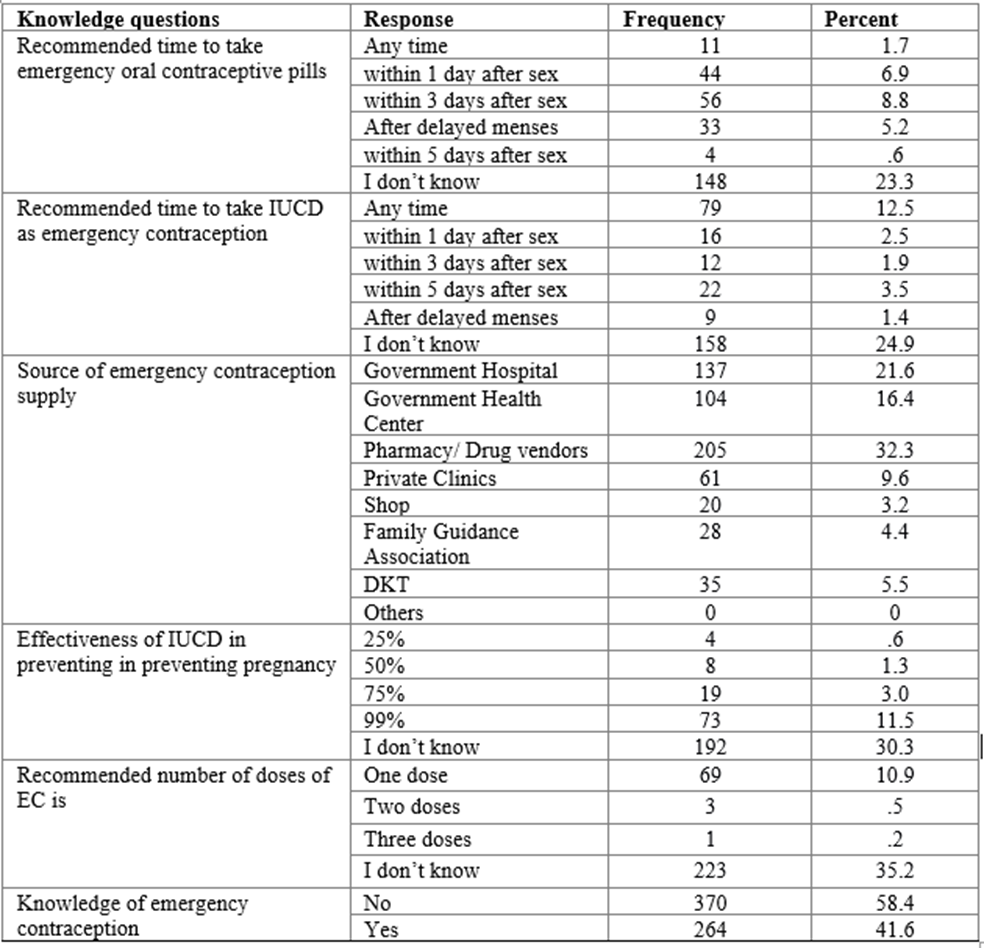
Table 4: Knowledge about the timing, efficacy, places to acquire, and dosing of emergency contraceptive among female students in two secondary high schools in Bole Sub-city, Addis Ababa, March 2024
Factors associated with knowledge about emergency contraception
In bivariate analysis, the variables, age, marital status, having a boyfriend, having discussed RH issues with parents, ever having had sexual intercourse, and a history of pregnancy were subjected to multivariate logistic regression analysis. In multivariate analysis, a significant difference was observed between predictors as follows: age of students, marital status (married), having a boyfriend, having discussed RH issues with parents, and EC.
Female students over 18 were 3.88 times more likely to have EC knowledge than those less than 15 years of age [AOR = 3.88; 95 % CI (1.09, 13.85)]. Marital status (married) had a significant effect on EC knowledge among the female students and ever married female students were found to be 3.64 times more likely to have EC knowledge than single female students [AOR = 3.64; 95 % CI (1.46, 9.04)]. Female students who had boyfriends were 1.85 times more likely to have EC knowledge than female students who had never had a boyfriend [AOR = 1.85; 95 % CI (1.15, 2.99)]. Female high school students who discussed RH issues with their parents were 1.80 times more likely to have EC knowledge than female students who had not discussed RH issues with their parents [AOR = 1.80; 95 % CI (1.24, 2.61)]. Female students who had ever had sexual intercourse in their lifetime were 5.22 times more likely to have EC knowledge than female students who had never had sexual intercourse [AOR = 5.22, 95 % CI (1.42,19.24)] (Table 5).
| Variables | Categories | Knowledge of EC | COR (95 % CI) | AOR (95 % CI) | |
| Yes | No | ||||
| Constant | 0.18(0.05, 0.59) | ||||
| Age | <15 years | 14 | 4 | 1 | 1 |
| 15-18 years | 309 | 207 | 2.34(0.76, 7.22) | 2.72 (0.81, 9.13) | |
| ≥18 years | 47 | 53 | 3.95(1.21,12.83)* | 3.88(1.09,13.85)* | |
| Marital status | Single | 610 | 96.2 | 1 | 1 |
| Married | 24 | 3.8 | 2.92(1.23, 6.93) | 3.64(1.46, 9.04)* | |
| Having boy friend | No | 332 | 206 | 1 | 1 |
| Yes | 38 | 58 | 2.46(1.58, 3.84)* | 1.85(1.15, 2.99)* | |
| Discussed RH issues with parents | No | 292 | 174 | 1 | 1 |
| Yes | 78 | 90 | 2.07(1.45, 2.96)* | 1.80(1.24, 2.61)* | |
| Experienced sexual intercourse | No | 361 | 239 | 1 | 1 |
| Yes | 9 | 25 | 4.94(2.20,11.10)* | 5.22(1.42,19.24)* | |
| Pregnant before | No | 364 | 255 | 1 | 1 |
| Yes | 6 | 9 | 2.87(0.97, 8.50) | 0.38(0.07, 2.07) | |
Table 5: Socio-demographic factors related to knowledge of EC among female secondary high school students in Bole Sub-city, Addis Ababa, and March 2024
1= indicators for reference group, * Significant association at p < 0.05
Socio-demographic characteristics of the participants
A total of 634 female high school students participated in the study with the response rate of 100%. Most of the 516 (81.4%) of female students were between 15 and 18 years of age. The mean age was 17.22 (SD ±1.536) years. Two hundred and twenty-eight (32.8%) of the female students were in grade 12. The majority of the female students 610 (96.2%) were single (unmarried), while 24 (3.8%) were ever married. Only 96 (15.1%) of the female students had boyfriends at the time of the study. Most of the 466 female students (73.5%) were followers of Orthodox Christianity. Of the total participants, a minority of female students 167 (26.3%) said that they had discussed Reproductive Health issues with their parents. More than half (354) (55.8%) of female students lived with both parents, 134 (21.1%) lived with their mother alone, 31 (4.9%) with their father alone, and 115 (18.1%) lived with others (friends, husband, alone, or relatives). About three-fourths (490) (77.3%) of the girls’ mothers had graduated from Grade 12 or below, 73 (11.5%) had acquired a certificate, 34(5.4 %) a diploma and 37 (5.8%) a bachelor’s degree or above. For the girls’ fathers, 445 (70.2%) grade 12 or below, 91(14.4%) had acquired certificates, 25 (3.9%) a diploma, and 73 (11.5%) a bachelor’s degree or above. Most of the students’ families 498 (78.5%) had monthly income below 10000 Birr (76USD) (Table 1).
| Variables | Frequency | Percentage | |
| Age | less than 15 years | 18 | 2.8 |
| 15 – 18 years | 516 | 81.4 | |
| 18 years and above | 100 | 15.8 | |
Grade level
| 9th | 128 | 20.2 |
| 10th | 145 | 22.9 | |
| 11th | 153 | 24.1 | |
| 12th | 208 | 32.8 | |
| Marital status | Never married | 610 | 96.2 |
| Ever married | 24 | 3.8 | |
| Having boyfriend | No | 538 | 84.9 |
| Yes | 96 | 15.1 | |
Ever discussed RH issues with parents | No | 465 | 73.3 |
| Yes | 167 | 26.3 | |
| Living conditions | Mother alone | 134 | 21.1 |
| Father alone | 31 | 4.9 | |
| Both parents | 354 | 55.8 | |
| Othera | 115 | 18.1 | |
Mothers’ educational level
| Grade 12 and below | 490 | 77.3 |
| Certificate | 73 | 11.5 | |
| Diploma | 34 | 5.4 | |
| Bachelor’s degree and above | 37 | 5.8 | |
Fathers’ educational level
| Grade 12 and below | 445 | 70.2 |
| Certificate | 91 | 14.4 | |
| Diploma | 25 | 3.9 | |
| Bachelor’s degree and above | 73 | 11.5 | |
| Family income per month | Below 10000 | 498 | 78.5 |
| 10000-20000 | 83 | 13.1 | |
| Above 20000 | 53 | 8.4 |
aOther living conditions include living with friends, with husband, alone, and with various relatives.
Table 1: Socio-demographic characteristics of female students in Bole Sub-city, Addis Ababa, March 2024, who participated in the study.
Sexual and risk behaviors and history of pregnancy
Of the total of 634 female participants, 34 (5.4%) had had sexual intercourse during their lifetime. Of those who had had sexual intercourse, 9 (1.4%) initiated sexual intercourse at the age of 18 years and above, while 25 (3.9 %) of them had been younger. For those who had ever had sexual intercourse, 15 (2.4%) reported a pregnancy; 8 (1.3%) became pregnant under 18 years and 7 (1.1%) 18 years or older. Of those pregnancies, 12 (1.9%) were
unwanted. Five girls (0.8%) continued with pregnancy to deliver a baby, while 10 (1.6%) induced an abortion The reasons mentioned for unwanted pregnancies were contraception failure three (0.5%), forgetting to take contraceptives three (0.5%), partner pressure to have unprotected intercourse three (0.5 %), condom slipped / broke two (0.3%) and one (0.2%) occurred due to forced sex. Five (0.8%) continued their pregnancy to deliver a baby, while 10 (1.6%) experienced an induced abortion (Table 2).
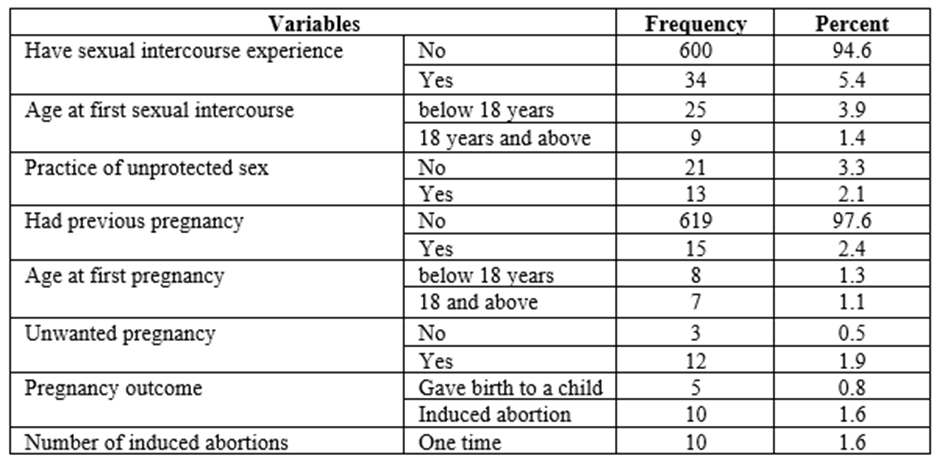
Table 2: Sexual and risk behaviors and history of pregnancy of female students.
Knowledge of emergency contraception
The prevalence of girls who had adequate EC knowledge was 264 (41.6%) (95 % CI: 37.77, 45.59). Almost half of the female students 294 (46.4%) had heard about EC. Of those who have heard about EC, 105 (16.6%) reported
they knew about ECP and 130 (20.5%) knew about IUCDs. The rest, 202 (47.6%) of the female students incorrectly mentioned condom and implant as methods of EC (Table 3).

Table 3: Knowledge of emergency contraceptives among female students in two secondary high schools in Bole Sub-city, Addis Ababa, March 2024.
Most female students 109 (17.2%) received information regarding EC from TV, followed by 80 (12.6%) from regular education they got in schools, friends/peers 74 (11.7%), family 66 (10.4 %), hospitals/health institutions 63 (9.9%), social media 62 (9.8 %), books 43 (6.8%) and radio 29 (4.7%) (Figure 2).
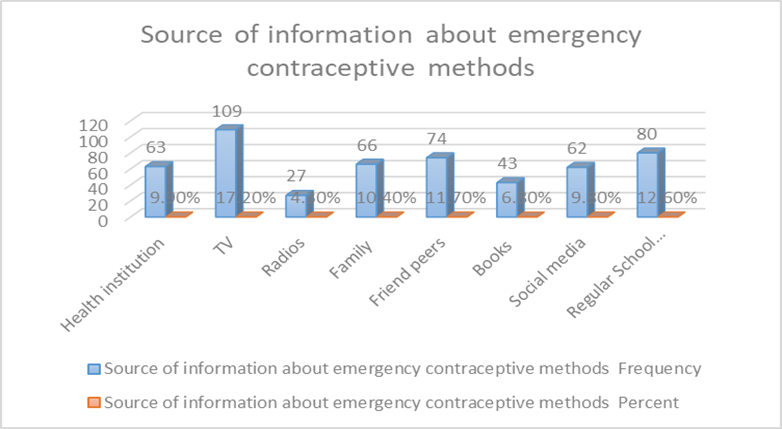
Figure 2: Frequency of source of information about emergency contraceptives for female students in two secondary high schools in Bole Sub-city, Addis Ababa, Ethiopia.
With regard to the recommended time limit ECP that could be used effectively, 148 (23.3%) of female students did not know it was within 72 hours after unprotected sexual intercourse. 56 (8.8%) female students
correctly identified 72 hours as the time limit to take ECP after unprotected sex.
Similarly, most of the female students 158 (24.9%) did not know the recommended time to have an IUCD inserted into the uterus to avoid pregnancy. This implies that most girls in this study did not have knowledge about the recommended time to take EC. A few, 22 (3.5%) correctly said that the IUCD should be inserted into the uterus within 5 days after unprotected sex.
When asked about where one can purchase (obtain) ECs, 205 (32.3%) of the girls indicated that they could get them from pharmacy/drug vendors followed by government hospitals and 137 (21.6%) indicated government health centers. A smaller group, 122 (19.2%) said EC could be obtained from private clinics and 104 (16.4%) mentioned government hospitals. A few, 61 (9.6%), identified family guidance associations, 35 (5.5%) and 28 (4.4%) mentioned DKT- International and shops as common places from where they could obtain ECs respectively.
Table 4 shows that 192 (30.3%) of the girls did not know the efficacy of IUCD in preventing unwanted pregnancy. Another 73 (11.5%) correctly indicated that the effectiveness of IUCD is 99% in preventing and reducing the risk of unwanted pregnancy. Only a few, 69 (10.9%) identified the recommended numbers of ECP doses (Table 4).
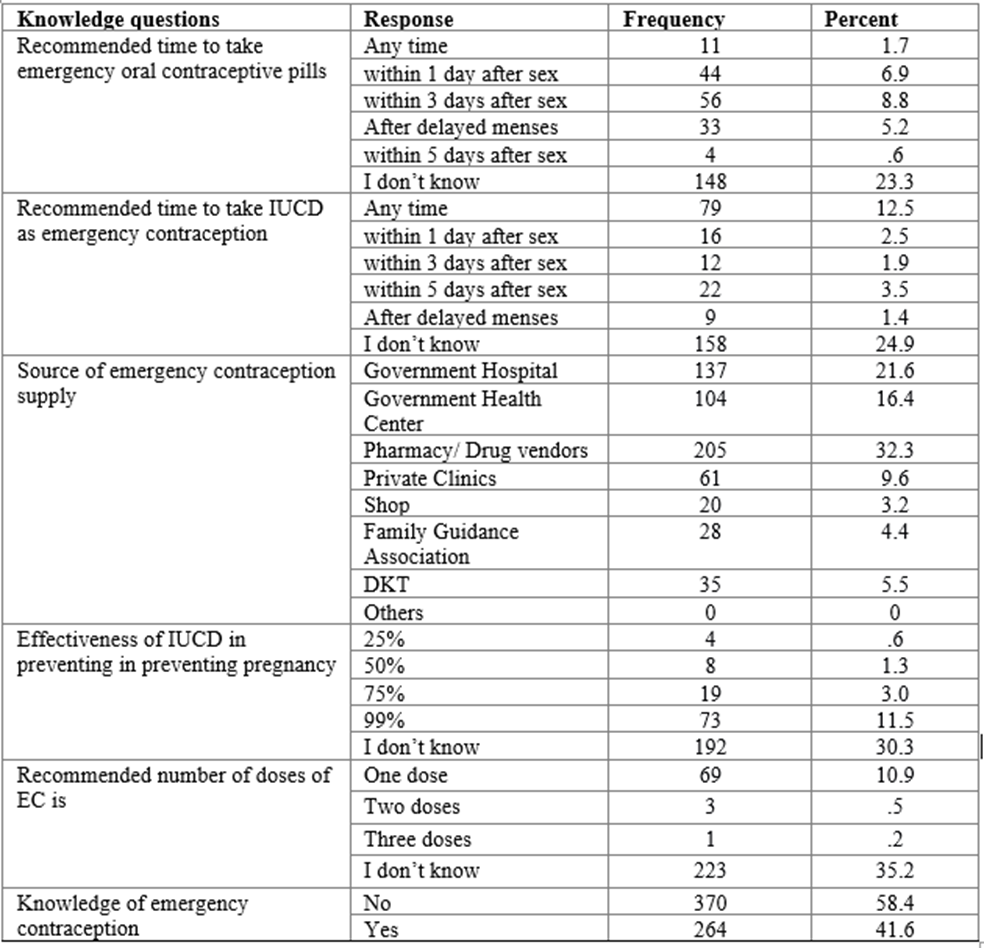
Table 4: Knowledge about the timing, efficacy, places to acquire, and dosing of emergency contraceptive among female students in two secondary high schools in Bole Sub-city, Addis Ababa, March 2024
Factors associated with knowledge about emergency contraception
In bivariate analysis, the variables, age, marital status, having a boyfriend, having discussed RH issues with parents, ever having had sexual intercourse, and a history of pregnancy were subjected to multivariate logistic regression analysis. In multivariate analysis, a significant difference was observed between predictors as follows: age of students, marital status (married), having a boyfriend, having discussed RH issues with parents, and EC.
Female students over 18 were 3.88 times more likely to have EC knowledge than those less than 15 years of age [AOR = 3.88; 95 % CI (1.09, 13.85)]. Marital status (married) had a significant effect on EC knowledge among the female students and ever married female students were found to be 3.64 times more likely to have EC knowledge than single female students [AOR = 3.64; 95 % CI (1.46, 9.04)]. Female students who had boyfriends were 1.85 times more likely to have EC knowledge than female students who had never had a boyfriend [AOR = 1.85; 95 % CI (1.15, 2.99)]. Female high school students who discussed RH issues with their parents were 1.80 times more likely to have EC knowledge than female students who had not discussed RH issues with their parents [AOR = 1.80; 95 % CI (1.24, 2.61)]. Female students who had ever had sexual intercourse in their lifetime were 5.22 times more likely to have EC knowledge than female students who had never had sexual intercourse [AOR = 5.22, 95 % CI (1.42,19.24)] (Table 5).
| Variables | Categories | Knowledge of EC | COR (95 % CI) | AOR (95 % CI) | |
| Yes | No | ||||
| Constant | 0.18(0.05, 0.59) | ||||
| Age | <15 years | 14 | 4 | 1 | 1 |
| 15-18 years | 309 | 207 | 2.34(0.76, 7.22) | 2.72 (0.81, 9.13) | |
| ≥18 years | 47 | 53 | 3.95(1.21,12.83)* | 3.88(1.09,13.85)* | |
| Marital status | Single | 610 | 96.2 | 1 | 1 |
| Married | 24 | 3.8 | 2.92(1.23, 6.93) | 3.64(1.46, 9.04)* | |
| Having boy friend | No | 332 | 206 | 1 | 1 |
| Yes | 38 | 58 | 2.46(1.58, 3.84)* | 1.85(1.15, 2.99)* | |
| Discussed RH issues with parents | No | 292 | 174 | 1 | 1 |
| Yes | 78 | 90 | 2.07(1.45, 2.96)* | 1.80(1.24, 2.61)* | |
| Experienced sexual intercourse | No | 361 | 239 | 1 | 1 |
| Yes | 9 | 25 | 4.94(2.20,11.10)* | 5.22(1.42,19.24)* | |
| Pregnant before | No | 364 | 255 | 1 | 1 |
| Yes | 6 | 9 | 2.87(0.97, 8.50) | 0.38(0.07, 2.07) | |
Table 5: Socio-demographic factors related to knowledge of EC among female secondary high school students in Bole Sub-city, Addis Ababa, and March 2024
1= indicators for reference group, * Significant association at p < 0.05
This study revealed that 41.6% of females at two secondary government high schools had adequate EC knowledge, which is in line with another study conducted in Ethiopia that found a rate of 38.7% [17] and in Ghana 38% [15] among reproductive age women between 15 and 24 years. This result is higher than a study conducted in Bench-Maji (34.6 %) [18], Jimma (14.4%) [19], Fiche town (13.3%) [20], and Goba (9.5%) [13] in Ethiopia. This may be due to the location of our study high schools in an urban setting exposing students to high levels of public and social media coverage. Another reason may be that in Bole Sub-city and other urban settings, girls attend RH clubs and there is a higher degree of openness among young female students in discussing Sexual and Reproductive Health (SRH) issues and this might contribute to a higher level of EC knowledge compared to girls in district towns in Ethiopia [21]. Our findings of EC knowledge were lower in than in a study conducted among secondary high school students in Nepal, which revealed that 65.3% of the female students had good EC knowledge [22]. This could be attributed to the availability of adolescent-friendly services, family planning services and EC services in Nepal [22]. This finding is also inconsistent with the studies of rates of EC knowledge conducted among female students at Addis Ababa University (60.4%) [23] and Debre Markos University (74.4%) [24] where female students were found to have good knowledge of EC. This difference may be due to University students having more EC awareness than high school students, and since education has a favorable impact on student’s ability to understand and seek reproductive health services and access to optimal EC methods for individual SRH needs [25,26,27].
EC knowledge of female students in our study was significantly higher among female students who were 18 years and or older. This finding about older age associated with more EC knowledge is consistent with the findings among female college students and women of reproductive age in Ethiopia [25, 28] and the University of Nairobi, Kenya [29] that showed that women 20 years and older had significantly higher level of EC knowledge compared to younger women. This may be because as girls become older, they are likely exposed to more EC information or seek more information about SRH issues.
This study found that girls who had ever discussed RH issues with their parents had better EC knowledge compared to those who had not done so. This result is consistent with a similar study conducted in the city of Wolkite, southern Ethiopia [12]. Ultimately, parent–daughter communication towards sexual and reproductive health issues is a principal tool and process by which parents and female adolescents discuss and transmit their sexual values, beliefs, attitudes, expectations, and knowledge of sexual and reproductive health issues. This could contribute to a reduction in unprotected sex and unwanted adolescent and teenage pregnancy and its consequences [30].
This study provides evidence that having a boyfriend created a statistically significant association with EC knowledge. A possible explanation might be that female students might receive current EC information from their boyfriends. Although we did not locate studies that showed a similar association, a study among female students in Wolkite town, southern Ethiopia [12] revealed that having partners (boyfriends) was found to be a significant predictor of EC utilization.
This study revealed that female students who had ever experienced sexual intercourse in the past had better EC knowledge of emergency contraception compared to female students who reported no sex in the past. This finding agrees with studies conducted in Ethiopia among female students at the College of Arts and Social Sciences of Adi Keyhong (Tigray) and Mettu University who had a significantly higher level of knowledge regarding emergency contraceptives compared to their female counterparts who had never had sexual intercourse [31]. This may hold true since there is a possibility that female students who engage in more sexual relationships are interested in learning about EC. In our study, a minority of female students had experienced sexual intercourse prior to the study period and this result was lower than a similar study conducted with students in Wolkite town, southern Ethiopia. that study showed that 40.5% of the female students had had sexual intercourse [12]. An explanation for the variation could be that rural youths initiate sexual intercourse (sexual debut) at a lower age than their urban counterparts [28]. A similar finding was described in a study in Mettu University (Ethiopia) among female students where there was no association found between pregnancy and level of EC knowledge [31].
Strength of the study: The study used a standard and pre-tested survey questionnaire.
Limitations of the study: Since the study topic addresses sensitive issues, the possibility of underestimation and self-presentational bias could not be excluded, even though the study was anonymous, confidentiality was assured, and respondents were asked to individually respond to the questions. Since the study design was cross-sectional, it is difficult to declare causation-and-effect relationships. Private schools were not included in the study. Therefore, the results cannot be used to generalize all female students in the study area. Despite this limitation, the study provides vital information that will inform public health education and service planners to develop a strategy to increase the awareness and knowledge of high school students towards EC in Addis Ababa.
The study showed that just under half of the female secondary government high school students in two schools in Bole Sub-city, Ethiopia had adequate EC knowledge.
Addis Ababa City Administration health and education departments and offices should work together to strengthen SRH programs, with special emphasis on modern contraceptives including EC by employing multi-sectoral platforms to prevent unwanted pregnancy among female high school students. Thus, adolescent SRH sex education and EC knowledge should be imparted early in the education system (incorporating SRH issues and teenage sexual behaviors into the curriculum starting right from grade 9 in the high schools) to prevent adolescent SRH-related problems.
There is also a need to expand Social and Behavior Change Communication (SBCC) (e.g. Information, Education, and Communication ( IEC) on emergency contraceptive) interventions and advocacy work aiming at adolescents’ SRH issues including EC, by using peer educators and various mass media outlets( TV, radio, social media) as the main means to broadcast appropriate EC information. Addis Ababa City Administration and Development Partners (Non-Governmental Organizations) who work in the area of youth empowerment and adolescent SRH should collaboratively organize EC training for pharmacists and drug vendor owners. This study has unveiled that the majority of female students indicated pharmacy/drug stores as the major places where EC could be obtained (purchased) and thus pharmacists as service providers can communicate and provide relevant information to the female students (adolescents) regarding doses and recommended time limit for the effective EC use. Training should be provided to high school teachers and parents in the areas of sex education and adolescent RH to help female students acquire EC information and leverage high school student EC knowledge.
Abbreviations
ACIPH Addis Continental Institute of Public Health
AOR Adjusted Odds Ratio
COR Crude Odds Ratio
EC Emergency Contraceptives
ECP Emergency Contraceptive Pills
EDHS Ethiopian Demographic Health Survey
FGAE Family Guidance Association of Ethiopia
IEC Information, Education, and Communication
IUCD Intra Uterine Contraceptive Device
RH Reproductive Health
SRH Sexual and Reproductive Health
TV Television
UNFPA United Nations Population Fund
Ethical clearance was obtained from the Addis Continental Institute of Public Health. A formal research permission letter was received from the Bole Sub-city Education Office, in Addis Ababa City Administration and submitted to the high schools. The students were informed about the purpose of the study, the importance of their participation, confidentiality issues, and study objectives. Written consent was obtained from each participant after explaining the objective of the study. For female students who were under 18 years of age, the investigator collected ascent from the principals of the schools. This was because of the study topic was sensitive and parents might not be interested to provide ascent on the behalf of their children. The objectives and importance of the study were informed to the study participants in accordance with the Declaration of Helsinki. The respondents’ background (characteristics) of the respondents and the information were kept confidential by not including the names and identification characteristics of the students. Only participants who consented were recruited to participate in the study.
Not applicable
Additional data and materials are available from the corresponding author on reasonable request.
Not applicable.
Not applicable.
The authors have indicated they have no potential conflicts of interest to disclose.
Not applicable.
MD and TSH conceived and designed the study concept and methodology. MD supervised the data collection. MD and AT analyzed and interpreted the data.MD wrote the first draft of the manuscript. All authors read and approved the final manuscript. MD accepts full responsibility for the work and/or the conduct of the study, had access to the data, and controlled the decision to publish.
We wish to thank Addis Continental Institute of Public Health for their support during the study and the female students from Aire Amba Secondary and Bole Preparatory high schools who took the time to participate in this study. The authors express heartfelt gratitude to Dr. Julia Challinor for her invaluable support, comments and suggestions.